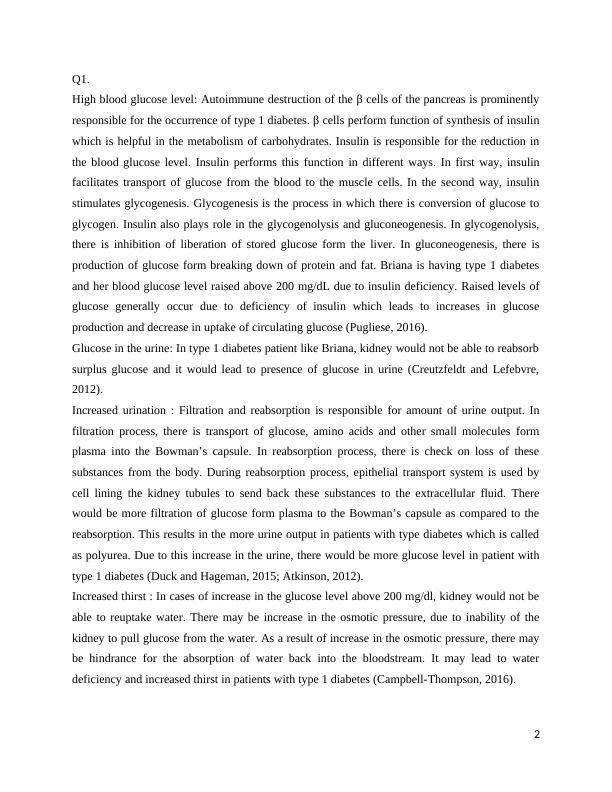Function of Synthesis of Insulin - MELS230
Added on 2020-03-07
6 Pages2220 Words58 Views
Bachelor of nursing1

Q1.High blood glucose level: Autoimmune destruction of the β cells of the pancreas is prominentlyresponsible for the occurrence of type 1 diabetes. β cells perform function of synthesis of insulinwhich is helpful in the metabolism of carbohydrates. Insulin is responsible for the reduction inthe blood glucose level. Insulin performs this function in different ways. In first way, insulinfacilitates transport of glucose from the blood to the muscle cells. In the second way, insulinstimulates glycogenesis. Glycogenesis is the process in which there is conversion of glucose toglycogen. Insulin also plays role in the glycogenolysis and gluconeogenesis. In glycogenolysis,there is inhibition of liberation of stored glucose form the liver. In gluconeogenesis, there isproduction of glucose form breaking down of protein and fat. Briana is having type 1 diabetesand her blood glucose level raised above 200 mg/dL due to insulin deficiency. Raised levels ofglucose generally occur due to deficiency of insulin which leads to increases in glucoseproduction and decrease in uptake of circulating glucose (Pugliese, 2016). Glucose in the urine: In type 1 diabetes patient like Briana, kidney would not be able to reabsorbsurplus glucose and it would lead to presence of glucose in urine (Creutzfeldt and Lefebvre,2012). Increased urination : Filtration and reabsorption is responsible for amount of urine output. Infiltration process, there is transport of glucose, amino acids and other small molecules formplasma into the Bowman’s capsule. In reabsorption process, there is check on loss of thesesubstances from the body. During reabsorption process, epithelial transport system is used bycell lining the kidney tubules to send back these substances to the extracellular fluid. Therewould be more filtration of glucose form plasma to the Bowman’s capsule as compared to thereabsorption. This results in the more urine output in patients with type diabetes which is calledas polyurea. Due to this increase in the urine, there would be more glucose level in patient withtype 1 diabetes (Duck and Hageman, 2015; Atkinson, 2012). Increased thirst : In cases of increase in the glucose level above 200 mg/dl, kidney would not beable to reuptake water. There may be increase in the osmotic pressure, due to inability of thekidney to pull glucose from the water. As a result of increase in the osmotic pressure, there maybe hindrance for the absorption of water back into the bloodstream. It may lead to waterdeficiency and increased thirst in patients with type 1 diabetes (Campbell-Thompson, 2016). 2

Increased appetite: In patients with type 1 diabetes, glucose would not be able to enter into thecells from the blood due to insulin deficiency and insulin resistance. Due to deficiency of glucosein the cells, body cannot utilize glucose as energy source. Due to loss of energy source, patientswith type 1 diabetes may feel more appetite. Increase in the consumption of food in response tothe appetite may not be helpful in getting rid of appetite sensation. On the other hand, thisincrease in the food consumption may lead to the augmented blood glucose level. This raisedblood glucose level increase appetite feeling (Reinehr, 2013). Ketones in the urine and blood : There would be increase in the early morning levels of ketonebodies in patients with type 1 diabetes which results in the ketoacidosis. Ketone bodies mainlyformed due to deficiency of energy because body burns its own fat. Ketone is the remaining acidafter the burning of the fat. Liver has role in the formation of ketones from the fatty acids. Afterreleasing ketone bodies in the blood, it is used as source of energy. Patients with type 1 diabetesgenerally does not respond to the consumed food. Hence, there may be more ketone bodiesformation in patients with type 1 diabetes (Simmons and Michels, 2015). Weight loss : Ketone production mainly occurs due to breakdown of protein and fat and it wouldlead to weight loss. This would result in the body mass wasting in children with type 1 diabetes. Q2.Validate the medication order: Prior to administration, nurse should validate the insulin bychecking brand name, storage condition and expiry date. Have comprehensive knowledge of the medication : Nurse should have comprehensiveknowledge of the medication in terms of storage condition, dose, route of administration,evaluation of the effectiveness of medication and adverse effects of medication.Prepare the medication safely: Nurse should take safety precaution during preparation of doselike cleaning of hands and rubber stopper of FlexPen with alcohol. Nurse should record bodyweight of Briana on regular basis because nurse need to adjust dose of insulin according to bodyweight. Assess the patient: Nurse should asses the Briana for allergic reactions because Aspart has thepotential to cause systemic allergic reactions. Allergy to insulin also should be assessed inBriana. As Aspart has potential to develop hyperthyroidism, Briana should be assessed forthyroid function. Hypokalemia may develop with the use of Aspart, hence Briana should be3

End of preview
Want to access all the pages? Upload your documents or become a member.
Related Documents
401014 - Health Variations Nursing - WSUlg...
|9
|2291
|80
Case Study on Type 1 Diabeteslg...
|10
|2235
|50
Type 1 Diabetes: Case Study Analysis - 401007lg...
|9
|2354
|409
High Blood Glucose Level Assignmentlg...
|10
|2139
|44
Pathophysiology of Diabetic Ketoacidosislg...
|16
|3646
|65
Key Factors Associated with Diabetes: A Comprehensive Discussionlg...
|6
|1585
|287
